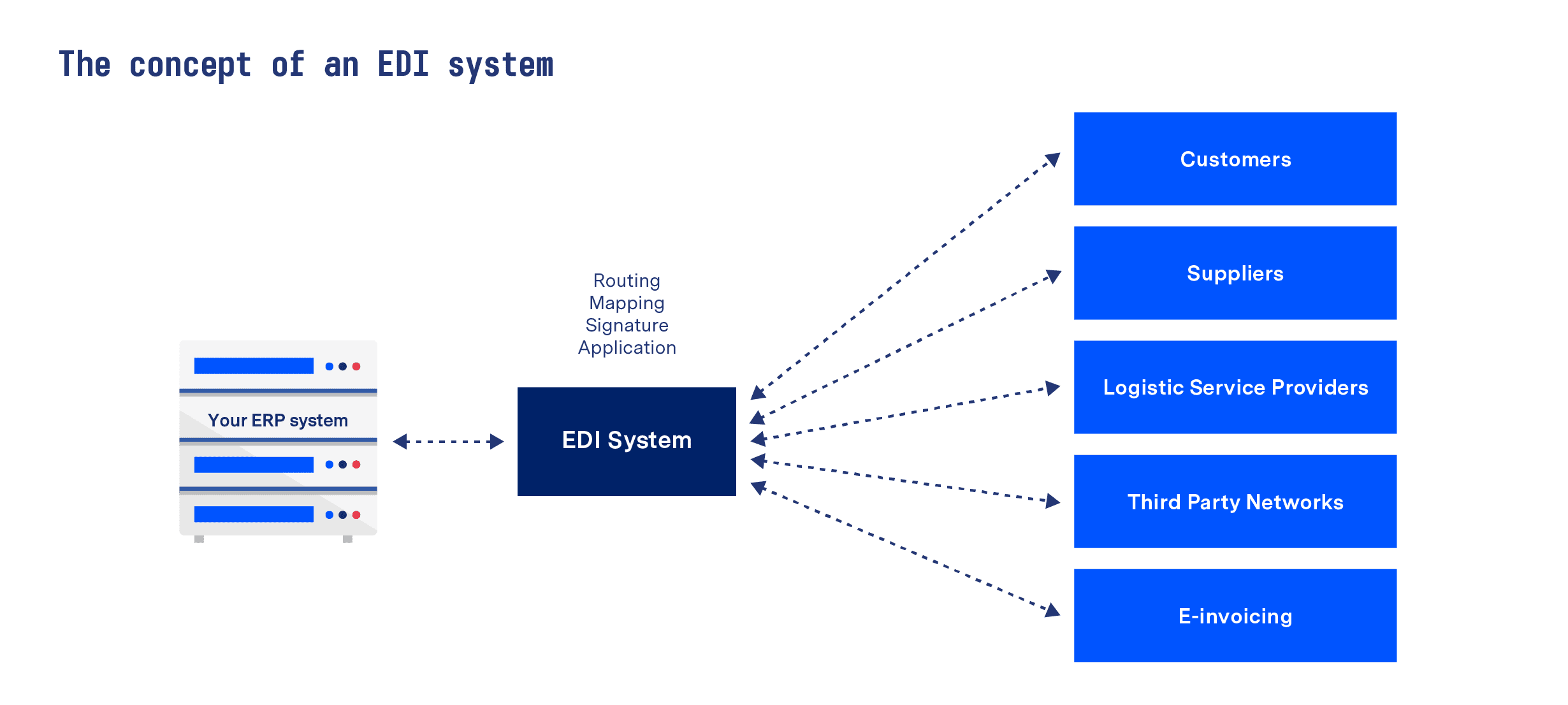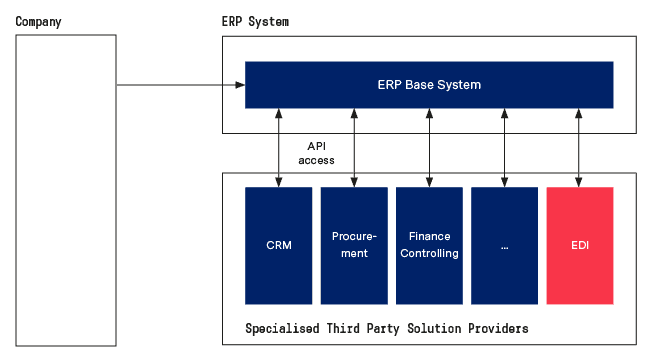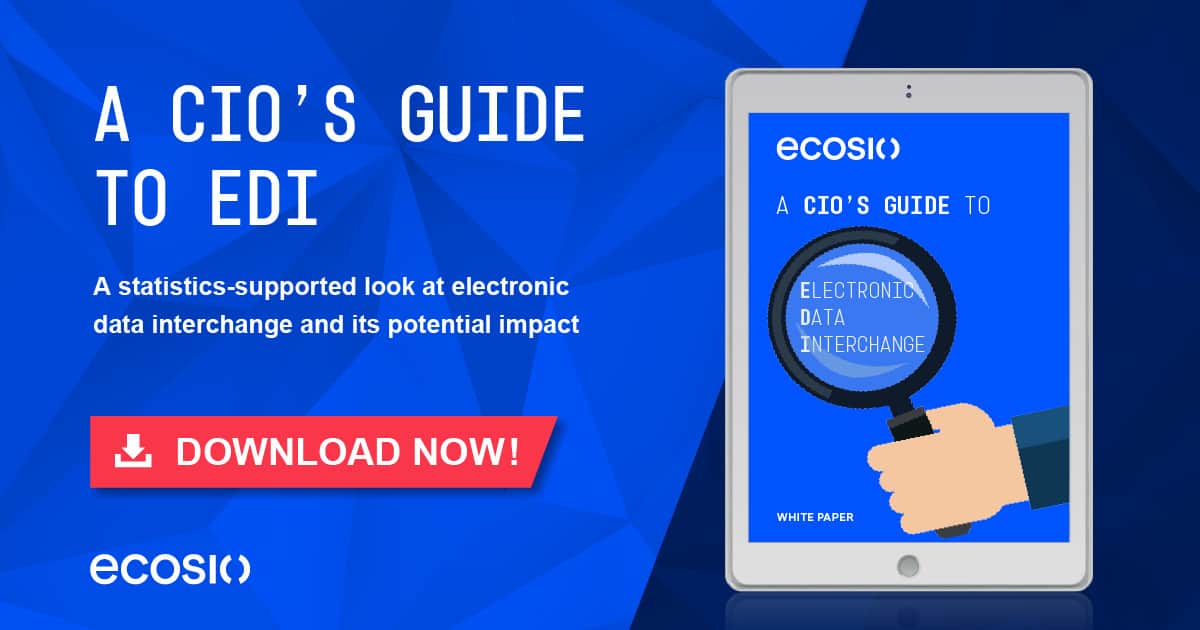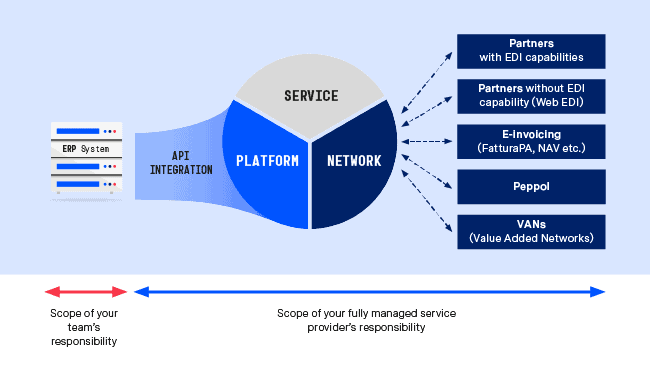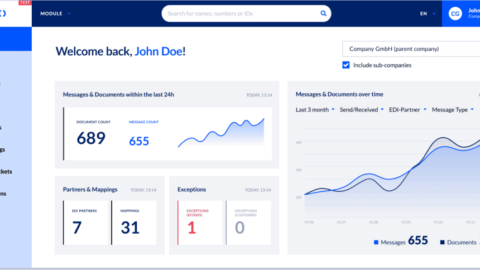While modern electronic data interchange (EDI) solutions can offer significant benefits to businesses, from time and cost savings to reduced risk and an increased competitive advantage, many businesses still persevere with outdated and inefficient B2B message exchange systems. One reason for this is the sheer number of options available to decision makers today, from local EDI converters and partially managed EDI solutions to cloud based solutions that are handled completely externally. Another key reason is a lack of awareness of what exactly the best modern EDI solutions can offer.
Thankfully, however, in recent years more and more businesses are recognising the benefits of modern EDI systems and are making the decision to implement more sophisticated solutions. In particular, fully managed EDI solutions, in which everything from initial setup to ongoing operation is handled by an external provider in the cloud, are proving remarkably popular.
In this article we’ll look at this recent trend and explore how such a solution works. But first let’s explore what we mean by an EDI system…
What is an EDI system?
An EDI system is the means by which a business exchanges electronic documents (such as orders, invoices and delivery notes) with its customers and suppliers automatically. While EDI systems can take several different forms, they can be broadly grouped into three main categories:
- On-premise (AKA local EDI converter) systems
- Platform as a service (AKA “managed”) systems
- Full service EDI solutions
As we break down in our infographic comparing these solutions, they differ significantly in terms of how much internal work is required to operate them. However, regardless of who does the work, all do largely the same job – allowing you to trade key documents with business partners quickly, easily and accurately (as minimal human intervention is required).
Why EDI systems are increasingly central to business operations
Businesses have never been so dependent on one another as they are today. Because of this, things can easily snowball when problems arise. As a result, it’s no surprise that more and more companies are taking steps to safeguard the sustainability of their supply chains by optimising automated B2B communication processes.
While EDI has long been essential for retail and automotive supply chains, going without EDI is simply not an option for any industry today. One reason for this is the benefits automated data exchange can offer – allowing businesses to react quickly (usually in real time) and ensure message exchange remains error-free. Another key reason is the fact that it is now demanded by an ever-growing number of businesses, with large businesses in particular keen to eliminate manual processes in exchanges with smaller suppliers in order to enjoy automated connections to all partners. Likewise, governments across the world are introducing mandatory e-invoicing for both B2G and B2B exchanges – meaning businesses have no choice but to implement a solution.
What makes an efficient EDI system?
To be successful, an EDI system must…
- …Be able to cover all of your needs. Which formats do you need to be able to map to? Is onboarding partners fast a priority? Is it important that your EDI data is protected in the event of system failure? While questions like these may seem obvious, many businesses fail to conduct an appropriate assessment of what their existing EDI needs are, which often results in a sub-optimal solution.
- …Fit your internal resources/expertise. There is no such thing as a one-size-fits-all EDI solution, so it’s important to select one that aligns with your internal capabilities and resources. For example, if you have substantial EDI expertise and personnel in-house, local EDI converter software may be an option for mapping setup, while message transmission may be outsourced to an expert provider. Alternatively, if you don’t have internal EDI expertise and want other departments to have the ability to access EDI data, a full service EDI solution makes more sense.
- …Streamline crucial processes. Obviously all EDI streamlines message exchange to some extent, but some EDI systems go further than others. For example, with a full service EDI solution all partner onboarding (from first contact right through to go-live) is handled by external EDI experts – reducing internal effort to next to nothing. Plus such solutions also help to optimise internal processes, as specialist departments are able to search for and access EDI data directly.
- …Be flexible. EDI requirements change over time, and it’s important that your EDI system is able to adapt if it is to continue to offer maximum value. With this in mind it’s best to steer clear of any EDI contracts that include steep “price cliffs” for changes in message volume or additional capabilities.
- …Work for you! Running an EDI system shouldn’t feel like a headache. A good EDI system should be something that works for you in the background, helping you to reduce risk, lower costs, save time and generally streamline connections in a futureproof way.
Modern EDI – the shift towards full external management
Most modern companies rely on the use of Enterprise Resource Planning (ERP) systems to conduct everyday operations, from processing sales orders to issuing invoices. It is in these systems too that data intended to be exchanged with other companies is created and consumed.
As every business is different, for most companies the best ERP system is one that is flexible. As a result, forward facing businesses are increasingly adopting flexible ERP solutions, where a core or base ERP system is extended with more tailored system packages from independent providers. These are known as ‘postmodern’ ERP systems.
As the image below shows, one of these specially tailored system packages is fully managed EDI. These modern EDI solutions can seamlessly integrate with on-premise or cloud-based ERP systems.
Fully managed EDI can be broken down into three distinct, yet mutually supportive elements. Together, these allow for the most comprehensive and successful EDI solution possible (i.e. ecosio’s).
The two foundational elements are the technical platform and the B2B network. The technical platform provides the necessary EDI features such as mapping or connecting suppliers via Web EDI. The B2B network, on the other hand, provides the means for reaching business partners – whether this is via a direct connection or via third-party networks or Value Added Networks (VANs).
In modern EDI solutions the third and final element – planning, execution and management – is arguably the most important of all, as it not only ensures that the entire EDI project is delivered turn-key ready, but that it will continue to function successfully after go-live. Significantly it is this part of the puzzle that is neglected by most EDI solutions. In such solutions it is the internal teams who must do the heavy lifting to transform the foundational technical elements into a reliable, future-proof solution.
How fully managed EDI works… at a glance
With a fully managed EDI solution your service provider takes over all EDI related tasks and enables not only your internal IT teams, but your entire company to experience a wide range of benefits. A sustainable IT strategy should be closely tied to a comprehensive, modern EDI solution in which mission critical EDI processes are fully managed. Placing all EDI related tasks such as partner onboardings, EDI message monitoring and proactive error resolution in the hands of a trusted EDI service provider not only relieves internal teams from everyday EDI tasks, but also positively impacts your overall business goals, as revenue is largely dependent on trading goods via EDI.
Significantly, at ecosio we offer an API-based integration, which ensues EDI processes become an integral part of the ERP system. As a result, in ecosio’s EDI solution message delivery statuses are directly visible on the ERP document (e.g. the customer invoice). This visibility provides reassurance to internal teams that EDI processes are working correctly. Further, if an error does occur, the respective document can be found easily, via a sophisticated full-text search feature.
For more information on how fully managed EDI works and the benefits it offers, see our more comprehensive article “What’s the Difference Between Managed and Fully Managed EDI?” on this subject.
How difficult is migrating to a new EDI system?
Not difficult at all… if you pick a system that meets your needs and resources that is.
Unfortunately, fear of changing a running system is one of the main reasons that businesses persist with outdated and inefficient EDI systems. However, ignoring a problem will never make it go away, and putting off a necessary migration project will only further damage your chances to gain a competitive advantage over others in your industry and delay your ability to enjoy the benefits good EDI can deliver.
While some businesses do make expensive mistakes when it comes to EDI, for those who plan their migration project properly and select the right EDI solution, migration can be a breeze. In particular, if you opt for a full service EDI solution (such as that offered by ecosio), everything from initial technical setup to ongoing operation is handled by your EDI provider – including partner onboardings, message monitoring and proactive error resolution. When switching to such an EDI system there is no need to worry about the migration disrupting ongoing operations, as all connections undergo rigorous testing and parallel operation before being put live.
Things to remember when selecting an EDI system
1) Preparation is key
As with any major project, planning = success. The more thorough you are when assessing your current capacity and requirements, the better placed you will be to select the right solution.
For more advice on planning your EDI project, see our dedicated blog article “How to Plan an EDI Project Correctly”.
2) Assess your internal resources
Although one of the main benefits of EDI is the fact that it streamlines previously time-consuming manual tasks, implementing and maintaining an EDI solution still requires effort. With this in mind it is important to consider both what your internal team can realistically handle and whether or not certain tasks would be better left to your provider.
Unfortunately many businesses overestimate internal capability and end up struggling to operate the solution or having to invest in additional personnel.
3) Think ahead
As we mentioned earlier, requirements can change quickly in EDI. Significantly, too, with governments across the world introducing e-invoicing regulations, and businesses demanding more and more data from their partners, changes may be outside your control.
By factoring in potential future needs (such as a Web EDI portal or routing via new protocols/VANs) when selecting an EDI system, you will avoid the possibility of being stuck with an ill-fitting, inflexible solution a few years down the line.
Could a full service EDI solution benefit your business?
At ecosio we’ve helped hundreds of businesses to revolutionise their B2B integration processes and experience the true potential of efficient EDI.
Our EDI as a Service solution takes all the hassle out of EDI, leaving you free to concentrate on what your business does best. From initial technical setup, partner onboarding, testing and go-live, to ongoing message monitoring and error handling, we manage everything so you don’t have to. To find out more about our unique solution, visit our Integration Hub page. Alternatively, feel free to get in touch – we’re always happy to help!
If you want to learn more about EDI, you may also be interested in our white paper “A CIO’s Guide to Electronic Data Interchange”. In this white paper we also explore the how modern EDI can benefit your business, the simple steps you can take to ensure you select the right solution, and the three most common EDI pitfalls.
Discover more about our updated product, ecosio.flow.
Download now your free copy of “A CIO’s Guide to Electronic Data Interchange”!


